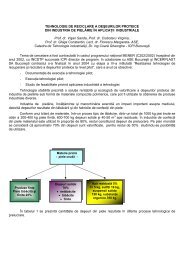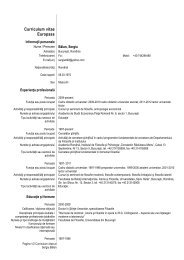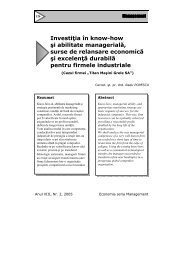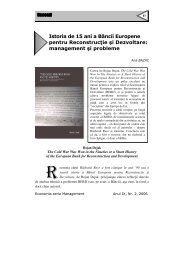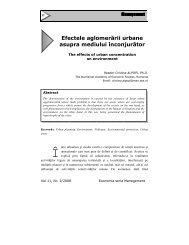Norlizan MAT RABI, Abdul Hadi ZULKAFLI, Mohd Hassan CHE HAAT
Norlizan MAT RABI, Abdul Hadi ZULKAFLI, Mohd Hassan CHE HAAT
Norlizan MAT RABI, Abdul Hadi ZULKAFLI, Mohd Hassan CHE HAAT
Create successful ePaper yourself
Turn your PDF publications into a flip-book with our unique Google optimized e-Paper software.
Economia. Seria Management Volume 14, Issue 1, 2011<br />
The web crawling procedures have been carried out during nighttime, on the same night<br />
(from 30.09.2010 time 11:49:34 PM until 01.10.2010 time 03:04:35 AM), in order to get a<br />
better and uniform insight, with no influence from day load activity on the servers. The<br />
various categories of results have been extracted and persistently stored in a database for<br />
further analysis.<br />
For an accurate interpretation of further results, we must specify the client-side context of<br />
the data gathering: a Realtek RTL8139/810x Family Fast Ethernet NIC, Internet<br />
Connection type ADSL, Internet Connection Speed 100Mbps provided by the national fix<br />
telecommunication provider. The configuration used in this empirical study represents a<br />
usual one for a Romanian Internet banking user.<br />
3. A Benchmark for Assessing Banks’ Websites Performance against Underlying<br />
Servers and Technologies<br />
Following the methodology presented in the previous section of this paper, we collected<br />
data from the websites of the 27 banks. The analysis revealed 19 different combinations of<br />
web technologies and servers. For each combination, we computed the average speed of<br />
download, measured in Kbps, for contents of following types: HTML, Text (PDF and<br />
MsWord documents) and Graphics (in JPEG, PNG and GIF formats).<br />
Our analysis continued with a K-means clustering algorithm of these web technologies &<br />
servers that revealed their grouping in terms of speed performance. Choosing k=4 and a<br />
number of 50 iterations we obtained four clusters with the following features and members<br />
(see table 1). This benchmark is useful for decision makers because it provides guidelines<br />
for predicting their websites’ performance.<br />
Based on the results illustrated in table 1 we make the following observations:<br />
• Upgrading to a newer version of web technologies and server does not<br />
necessary result in better performance in all categories of content (HTML, Text, Graphics)<br />
compared to the previous version;<br />
• Using a mix of web technologies (e.g. ASP.NET & PHP) instead of one does<br />
not make a significant difference in content retrieval speed;<br />
• Knowing the average speed of web content transfer for a web<br />
technology/server configuration can be useful in designing the website structure.<br />
For example, considering a PHP v4.3.1/APA<strong>CHE</strong> Server v1.3.29 as a web<br />
technology/server configuration for the Internet website of a bank, loading a page with<br />
1MB of graphics contents and 500 KB of HTML contents results in an average time of<br />
30.14+19.40 =49.54 seconds. Considering their clients’ perspective, banks can use a<br />
caching strategy to increase response time for frequently requested contents and avoid<br />
refreshing repetitive contents by using frames. Also, slow pages should be redesigned,<br />
accompanied by the introduction of a custom search engine in the bank’s website to allow<br />
faster retrieval of desired contents without wait times on each intermediary page between<br />
the home page and the page of interest.<br />
95



